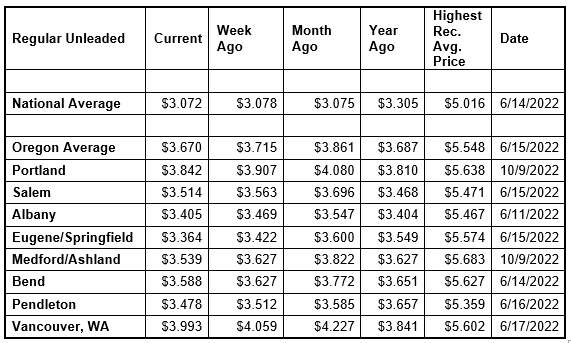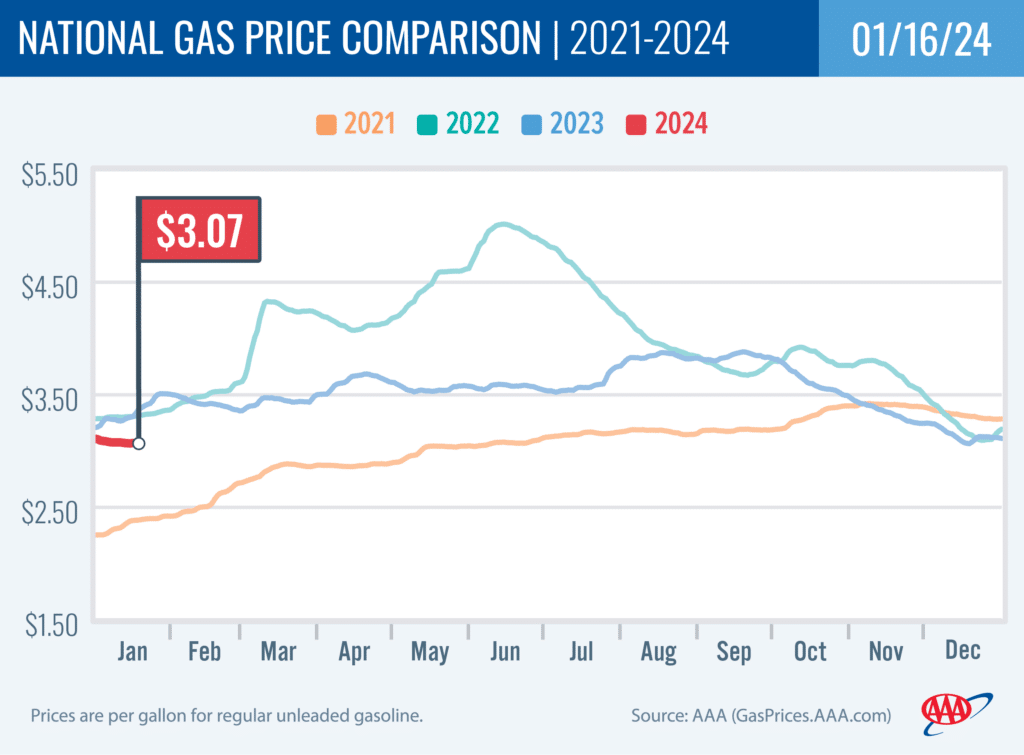PORTLAND, Ore., – Gas prices are showing little movement this week. The national average has barely budged and most states, including Oregon, are seeing prices change by only a few cents. The factors are fairly stable crude oil prices and ho-hum demand for gas. For the week, the national average for regular edges down half a cent to $3.07 a gallon. The Oregon average slips nearly five cents to $3.67.

“The winter blahs will likely keep pump prices moving up and down a few cents for now. However, cold weather has the potential to impact refinery production, which could send prices higher in some areas,” says Marie Dodds, public affairs director for AAA Oregon/Idaho. “Even though the national average is close to $3 a gallon, it may not drop below that threshold before pump prices begin their seasonal climb.”
The national average is at its lowest price since June 2021. The Oregon average is at its lowest price since July 2021.
Most Oregon counties have averages below $4 a gallon. The only counties with averages at or above $4 are:
Coos $4.05
Curry $4.24
Gas prices normally rise in the first and/or second quarters of the year. The factors include refinery maintenance season, the normal seasonal growth in demand, and the switch from winter-blend fuel to summer-blend, which is more expensive to produce. Summer-blend gas helps reduce emissions from gasoline during the warm summer months. More info on summer- and winter-blend gasoline can be found at the EPA website.
Crude oil prices continue to be volatile on concerns surrounding mounting geopolitical tensions in the Middle East after attacks on commercial vessels in the Red Sea. The conflict between Israel and Hamas has led to additional violence in the West Bank, Levanon, Syria and Iraq. While Israel and the Palestinian territory are not oil producers, there’ve been concerns that the conflict could spread in the Middle East, which could potentially impact crude production in other oil-producing nations in the region.
Crude oil is trading around $72 today compared to $72 a week ago and $79 a year ago. In 2023, West Texas Intermediate ranged between $63 and $95 per barrel. Crude reached recent highs of $123.70 on March 8, 2022, shortly after the Russian invasion of Ukraine, and $122.11 per barrel on June 8, 2022. The all-time high for WTI crude oil is $147.27 in July 2008.
Crude oil is the main ingredient in gasoline and diesel, so pump prices are impacted by crude prices on the global markets. On average, about 57% of what we pay for in a gallon of gasoline is for the price of crude oil, 8% is refining, 20% distribution and marketing, and 15% are taxes, according to the U.S. Energy Information Administration.
Demand for gas in the U.S. increased from 7.95 million to 8.33 million b/d for the week ending January 5, according to the U.S. Energy Information Administration (EIA). This compares to 7.56 million b/d at the same time last year. Meanwhile, total domestic gasoline stocks increased significantly by 8 million bbl to 245 million bbl.
The slight uptick in demand has limited pump price drops, causing the national average to stagnate. However, if oil prices continue to drop, drivers could continue to see pump prices trickle lower.
Quick stats
Oregon is one of 35 states with lower prices now than a week ago. Arizona (-10 cents has the biggest weekly drop. Wisconsin (+13 cents) has the largest week-over-week increase. Only five states have seen prices change by 10 cents or more in the last week.
Hawaii ($4.67) has the most expensive gas in the nation. California ($4.56) is second, and Washington ($4.01) is third. These are the three states with averages at or above $4, same as a week ago. This week 17 states and the District of Columbia have averages in the $3-range. Thirty states have averages in the $2 range this week.
The cheapest gas in the nation is in Oklahoma ($2.56) and Arkansas ($2.63). No state has had an average below $2 a gallon since January 7, 2021, when Mississippi and Texas were below that threshold.
The difference between the most expensive and least expensive states is $2.11 this week, compared to $2.09 a week ago.
Oregon is one of 40 states and the District of Columbia with lower prices now than a month ago. The national average is the same and the Oregon average is 20 cents less than a month ago. This is the sixth-largest monthly drop in the nation. Idaho (-32 cents) has the largest monthly drop. Florida (+20 cents) has the largest month-over-month increase.
Oregon is one of 48 states and the District of Columbia with lower prices now than a year ago. The national average is 23 cents less and the Oregon average is two cents less than a year ago. Colorado (-67 cents) has the largest yearly decrease. California (+13 cents) and Washington (+2 cents) are the only states with year-over-year increases.
West Coast
The West Coast region continues to have the most expensive pump prices in the nation with six of the seven states in the top 10. It’s typical for the West Coast to have six or seven states in the top 10 as this region tends to consistently have fairly tight supplies, consuming about as much gasoline as is produced. In addition, this region is located relatively far from parts of the country where oil drilling, production and refining occurs, so transportation costs are higher. And environmental programs in this region add to the cost of production, storage and distribution.
| Rank | Region | Price on 1/16/24 |
| 1 | Hawaii | $4.67 |
| 2 | California | $4.56 |
| 3 | Washington | $4.01 |
| 4 | Nevada | $3.81 |
| 5 | Oregon | $3.67 |
| 6 | Alaska | $3.54 |
| 7 | Pennsylvania | $3.33 |
| 8 | New York | $3.28 |
| 9 | Vermont | $3.22 |
| 10 | District of Columbia | $3.20 |
As mentioned above, Hawaii has the most expensive gas in the country. California, Washington, Nevada, Oregon, and Alaska round out the top six. Arizona is 12th. Oregon is fifth most expensive for the 13th week in a row.
Like most every other state in the nation, six of the seven states in the West Coast region are seeing week-over-week declines. Arizona (-13 cents) has the largest weekly drop in the nation and the region. California (-10 cents), Nevada (-9 cents), Washington (-6 cents), Oregon (-5 cents), and Alaska (-4 cents) also have week-over-week declines. Hawaii (+2/10ths of a cent) is the only state in the region with a weekly increase.
The refinery utilization rate on the West Coast fell from 88.4% to 85.9% for the week ending January 5. This rate has ranged between about 73% to 96% in the last year. The latest national refinery utilization rate is down from 93.5% to 92.9%.
According to EIA’s latest weekly report, total gas stocks in the region increased from 28.88 million bbl. to 29.49 million bbl.
A lower refinery utilization rate can put upward pressure on pump prices, while an increase in gasoline stocks can put downward pressure on pump prices.
Oil market dynamics
Crude oil prices have been fairly stable over the last week, despite tensions in the Middle East including the shipping attacks and disruptions in the Red Sea. In addition, the EIA reported that total domestic commercial crude stocks increased by 1.3 million bbl to 432.4 million bbl. Rising stocks signal that demand could be softening, helping to push prices down as the nation settles into winter.
At the close of Friday’s formal trading session, WTI added 66 cents to settle at $72.68. U.S. markets were closed Monday in observance of Martin Luther King Jr. Day. Today crude is trading around $72 compared to $72 a week ago. Crude prices are about $6 lower than a year ago.
Drivers can find current gas prices along their route with the free AAA Mobile app for iPhone, iPad and Android. The app can also be used to map a route, find discounts, book a hotel and access AAA roadside assistance. Learn more at AAA.com/mobile.

Diesel
For the week, the national average slips two cents to $3.93 a gallon. The record high is $5.816 set on June 19, 2022. The Oregon average falls five cents to $4.24. The record high is $6.47 set on July 3, 2022. A year ago the national average for diesel was $4.60 and the Oregon average was $4.72.
Find current fuel prices at GasPrices.AAA.com.
AAA news releases, high resolution images, broadcast-quality video, fact sheets and podcasts are available on the AAA NewsRoom at NewsRoom.AAA.com.
Find local news releases at https://oregon.aaa.com/community/media/media-contacts.html
Fuel prices are updated daily at AAA’s Daily Fuel Gauge at AAA Gas Prices. For more info go www.AAA.com. AAA Oregon/Idaho provides more than 890,000 members with travel, insurance, financial and automotive-related services, and is an affiliate of AAA National, serving more than 64 million motorists in North America.

